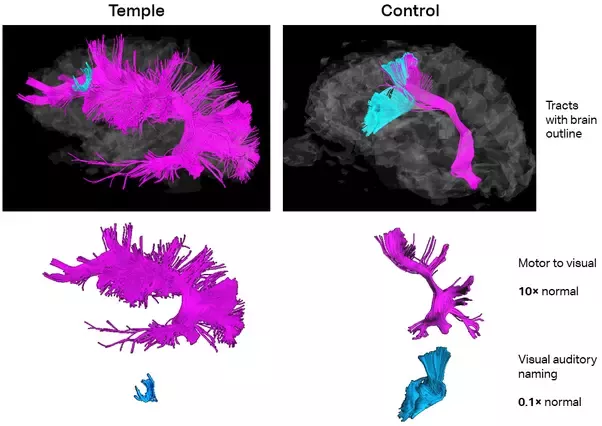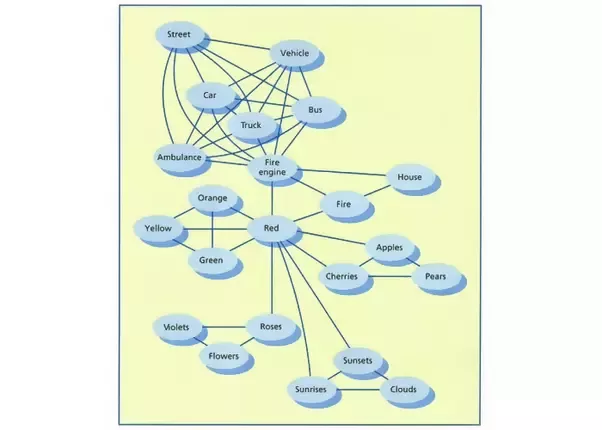Temple Grandin:
I have observed that there are three different specialized autistic/Asperger cognitive types. They are:
(1) Visual thinkers such as I, who are often poor at algebra.
(2) Verbal specialists who are good at talking and writing but they lack visual skills.
(3) Pattern thinkers such as Daniel Tammet, who excel in math and music but may have problems with reading or writing composition.
Visual, verbal, and pattern thinkers
Temple Grandin describes autism as a behavioral profile that has strengths and weaknesses. She has suggested that autistic people’s thinking styles fall into one of three categories: visual thinkers; verbal/logic thinkers; and musical/mathematical thinkers. Although each person falls predominantly into one category, one can have a mixture of two or three.[1]Temple Grandin’s three types of Thinkers in Autism | Life With Aspergers[2]Autism – The Way I See It | Temple Grandin Or indeed more than three, based on personal reports. But let’s look at Grandin’s model.
Visual thinkers
Visual thinkers think in pictures and see things—either in their mind or physically—in order to process information. Visual thinkers may have a photographic memory. Temple Grandin writes:[3]How does visual thinking work in the mind of a person with autism? A personal account (Grandin, 2009)
My mind is similar to an Internet search engine that searches for photographs. I use language to narrate the photo-realistic pictures that pop up in my imagination. When I design equipment for the cattle industry, I can test-run it in my imagination, similar to a virtual reality computer program. All my thinking is associative and not linear. To form concepts, I sort pictures into categories similar to computer files. To form the concept of orange, I see many different orange objects, such as oranges, pumpkins, orange juice, and marmalade. When I design livestock facilities, I can test run the equipment in my imagination similar to a virtual reality computer program.
My mind is associative and does not think in a linear manner. If you say the word ‘butterfly’, the first picture I see is butterflies in my childhood backyard. The next image is metal decorative butterflies that people decorate the outside of their houses with and the third image is some butterflies I painted on a piece of plywood when I was in graduate school. Then my mind gets off the subject and I see a butterfly cut of chicken that was served at a fancy restaurant approximately three days ago. The memories that come up first tend to be either early childhood or something that happened within the last week.
A teacher working with an autistic child may not understand the connection when the child suddenly switches from talking about butterflies to talking about chicken. If the teacher thinks about it visually, a butterfly cut of chicken looks like a butterfly.

Verbal/logic thinkers
Verbal/logic thinkers tend to be good at learning languages, and have an affinity for words, literature, and speech. They love to make lists, and will often memorize (mundane) things such as train timetables & routes, stories in alphabetical order, and software product codes.
Verbal/logic thinkers tend to have a huge memory for verbal facts on all kinds of things, such as film stars, sporting events, publications, or historical events. Areas of interest often include history, geography, weather, and sports statistics. Parents and teachers can use these interests and talents as a motivation for learning less interesting parts of academics.
Some verbal/logic thinkers are exceptionally adept at learning many different foreign languages, but they tend to be poor at drawing and other visual thinking skills.
Music and math (‘pattern’) thinkers
Michael Shermer defined patternicity as “the tendency to find meaningful patterns in both meaningful and meaningless data.”Music/math/pattern thinkers think in patterns. For thousands of years mathematicians have studied patterns in music—finding that geometry can describe chords, rhythms, scales, and octave shifts for example, and recently researchers have even found that if mapped out, these constructs assume Möbius strip-like features.[4]Mathematical Impressions: Making Music With a Möbius Strip (Hart, 2013) | Simons Foundation[5]Bach and the musical Möbius strip | Plus Magazine When creating music, composers work towards a pattern that is musically/mathematically sound.
Chess masters think not in pictures or words, but are good at recognizing patterns. Pattern thinking is a more abstract form of visual thinking; thoughts are in patterns instead of photo-realistic pictures. Pattern thinkers see patterns and relationships between numbers. Some of the best descriptions are in Daniel Tammet’s book ‘Born on a Blue Day’ (Tammet, 2006) and in Jerry Newport’s book ‘Mozart and the Whale’ (Newport et al., 2007). The weak areas in pattern thinkers are usually reading and writing composition.[6]How does visual thinking work in the mind of a person with autism? A personal account (Grandin, 2009)
The same is true in visual arts. Vincent van Gogh’s later paintings had all sorts of swirling, churning patterns in the sky—clouds and stars that he painted as if they were whirlpools of air and light. And, it turns out, that’s what they were!
In 2006, physicists compared van Gogh’s patterns of turbulence with the mathematical formula for turbulence in liquids. The paintings date to the 1880s. The mathematical formula dates to the 1930s. Yet van Gogh’s turbulence in the sky provided an almost identical match for turbulence in liquid.[7]How an Entirely New, Autistic Way of Thinking Powers Silicon Valley (2013) | Wired
The three kinds of minds—visual, verbal, and pattern thinkers—naturally complement one another. In successful collaborations, different kinds of thinkers work together to create a product that is greater than the sum of its parts. Temple Grandin writes in her book ‘The Autistic Brain: Thinking Across the Spectrum’:[8]The Autistic Brain: Thinking Across the Spectrum (Grandin, 2013) | Google Books
What if we recognized these categories consciously and tried to make the various pairings work to our advantage? What if each of us was able to say, Oh, here’s my strength, and here’s my weakness—what can I do for you, and what can you do for me?
If people can consciously recognize the strengths and weaknesses in their ways of thinking, they can then seek out the right kinds of minds for the right reasons. And if they do that, then they’re going to recognize that sometimes the right mind can belong only to an autistic brain.
Bottom-up, analytical, lateral, and associative thinkers
Bottom-up thinking
Bottom-up thinking is a process of taking in details and building up from there. The fragmented bits and pieces are structured and categorized, and then an induction is made—a process that brings rise to something—and the bits and pieces are reassembled into something that is coherent, and leads to a satisfactory conclusion.[9]How an Entirely New, Autistic Way of Thinking Powers Silicon Valley (2013) | Wired Autistic individuals have been recognized to have almost effortless associative thinking skills and tend to be prone to “bottom-up” processing. Temple Grandin writes:[10]Extra with Temple Grandin on autism innovation: the secrets of Silicon Valley (2015) | The New Idealist
I’m good at trawling through the Internet through vast amounts of journal articles and then pick out what are the really important things. I then synthesize all of this resource down into one short paragraph…
That’s something that I’m good at doing… I’m a bottom-up thinker—I take the details and put them together.
Autistic people are “details-before-the-concept” thinkers, while non-autistic people are “concept-before-the-details” thinkers. What this means is that the autistic mind approaches its environment—a bottom-up approach—while the non-autistic mind utilizes top-down thinking—drawing on prior learning and memories. As such, all thoughts and actions are contextualized based upon prior knowledge—and thus, are also constrained by this.
A top-down thinker sees a set of symptoms and fits it into a prior box. The autistic mind is not similarly constrained, and is thus more prone to generating novel ideas, and finding innovative solutions. Additionally, the autistic mind is bombarded with sensory information through multiple stimuli, thus processing a greater extent of information that can be utilized for innovative thinking.
Associative thinkers
Autistic individuals have an associative rather than linear way of thinking, where one thought connects to another, and another—like a great interconnected web of related and more loosely associated concepts. Temple Grandin writes:[11]How does visual thinking work in the mind of a person with autism? A personal account (Grandin, 2009)
My mind is associative and does not think in a linear manner. If you say the word ‘butterfly’, the first picture I see is butterflies in my childhood backyard. The next image is metal decorative butterflies that people decorate the outside of their houses with and the third image is some butterflies I painted on a piece of plywood when I was in graduate school.
Then my mind gets off the subject and I see a butterfly cut of chicken that was served at a fancy restaurant approximately 3 days ago. The memories that come up first tend to be either early childhood or something that happened within the last week.

Research studies demonstrated that autistic people were proficient at making unusual word associations as well as having an increased ability to generate creative (scientific) ideas.[12]Dimensional schizotypy, autism, and unusual word associations in artists and scientists (Rawlings & Locarnini, 2007)
Analytical thinkers
Autistic people tend to reason in a more logically consistent manner than neurotypicals. There is decreased susceptibility to the framing effect in autistic people, who demonstrate an ‘unusual enhancement in logical consistency’.The way options are framed can induce bias in decision-making. Options presented in a “gain” frame (you keep $30 of an initial $50) are preferred to mathematically equivalent options presented in a “loss” frame (you lose $20 of an initial $50). The increase in participants choosing the option when in the gain frame compared to the loss frame is known as the ‘framing effect’.[13]Emotional decision-making in autism spectrum disorder: the roles of interoception and alexithymia (Shah, Catmur & Bird, 2016)
Framing effects are particularly prone to emerge during uncertainty, and research suggests it may be the co-occurrence of alexithymia and autism that lies behind the use of logic. Alexithymia is the inability to recognize one’s own or another’s feelings—leaving only logic as a way to decipher the world. The research indicates that although framing effects are associated with interoception and alexithymia in the neurotypical population, emotional and interoceptive signals have less impact on the decision-making process in autistic people.
Lateral thinkers
Autistic individuals tend to be excellent problem solvers; they are up to 40% faster at it.[14]Study finds autistics better at problem-solving (2009) | EurekAlert Temple Grandin writes:[15]How does visual thinking work in the mind of a person with autism? A personal account (Grandin, 2009)
My mind is similar to an Internet search engine that searches for photographs. I use language to narrate the photo-realistic pictures that pop up in my imagination. When I design equipment for the cattle industry, I can test run it in my imagination similar to a virtual reality computer program.
All my thinking is associative and not linear. To form concepts, I sort pictures into categories similar to computer files. To form the concept of orange, I see many different orange objects, such as oranges, pumpkins, orange juice and marmalade.
Comments
Let us know what you think!